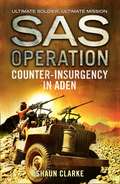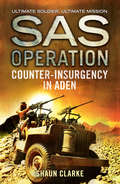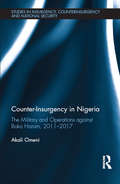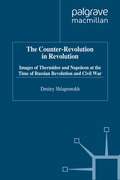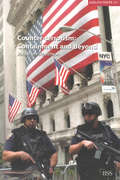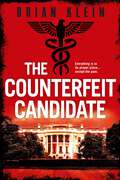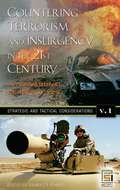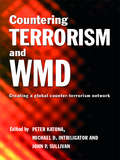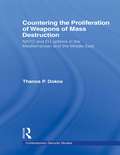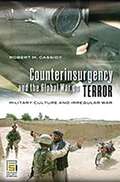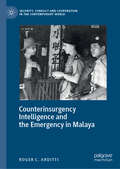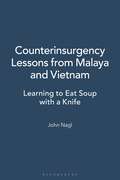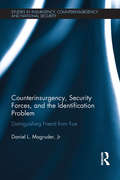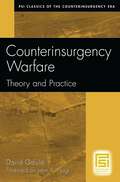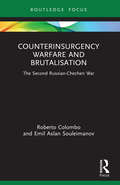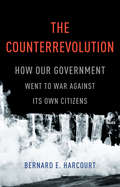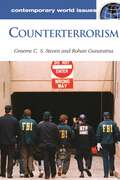- Table View
- List View
Counter-insurgency In Aden (Sas Operation Series (PDF).)
by Shaun ClarkeUltimate soldier. Ultimate mission. But will the SAS be able to rid Yemen of its unstoppable guerrillas? Aden, 1964, and the British are waging two different kinds of war. Inhabitants of northern Yemen’s forbidding mountainous region of Radfan are conducting guerrilla attacks against the British. Armed by the Egyptians and trained by the communist Yemenis, they seem an invincible fighting force. With only one hope of beating them, the British draft in an even more tenacious group of soldiers – the SAS! Their mission: to parachute into enemy territory at night, establish concealed observation posts high in the mountains, and direct air strikes on the rebels moving through the sun-baked passes. At the same time, in an even more dangerous campaign, two- or three-man SAS teams disguised as Arabs must infiltrate the souks and bazaars of the port of Aden in an attempt to ‘neutralise’ leading members of the National Liberation Front. But will their disguise allow them to get close enough to their targets, or get out again alive…?
Counter-insurgency in Aden (SAS Operation)
by Shaun ClarkeUltimate soldier. Ultimate mission. But will the SAS be able to rid Yemen of its unstoppable guerrillas?
Counter-insurgency In Aden (Sas Operation Ser.)
by Shaun ClarkeUltimate soldier. Ultimate mission. But will the SAS be able to rid Yemen of its unstoppable guerrillas? Aden, 1964, and the British are waging two different kinds of war. Inhabitants of northern Yemen’s forbidding mountainous region of Radfan are conducting guerrilla attacks against the British. Armed by the Egyptians and trained by the communist Yemenis, they seem an invincible fighting force. With only one hope of beating them, the British draft in an even more tenacious group of soldiers – the SAS! Their mission: to parachute into enemy territory at night, establish concealed observation posts high in the mountains, and direct air strikes on the rebels moving through the sun-baked passes. At the same time, in an even more dangerous campaign, two- or three-man SAS teams disguised as Arabs must infiltrate the souks and bazaars of the port of Aden in an attempt to ‘neutralise’ leading members of the National Liberation Front. But will their disguise allow them to get close enough to their targets, or get out again alive…?
Counter-Insurgency in Nigeria: The Military and Operations against Boko Haram, 2011-2017 (Studies in Insurgency, Counterinsurgency and National Security)
by Akali OmeniThis book offers a detailed examination of the counter-insurgency operations undertaken by the Nigerian military against Boko Haram between 2011 and 2017. Based on extensive fieldwork conducted with military units in Nigeria, Counter-Insurgency in Nigeria has two main aims. First, it seeks to provide an understanding of the Nigerian military’s internal role – a role that today, as a result of internal threats, pivots towards counter-insurgency. The book illustrates how organizational culture, historical experience, institutions, and doctrine, are critical to understanding the Nigerian military and its attitudes and actions against the threat of civil disobedience, today and in the past. The second aim of the book is to examine the Nigerian military campaign against Boko Haram insurgents – specifically, plans and operations between June 2011 and April 2017. Within this second theme, emphasis is placed on the idea of battlefield innovation and the reorganization within the Nigerian military since 2013, as the Nigerian Army and Air Force recalibrated themselves for COIN warfare. A certain mystique has surrounded the technicalities of COIN operations by the Army against Boko Haram, and this book aims to disperse that veil of secrecy. Furthermore, the work’s analysis of the air force’s role in counter-insurgency is unprecedented within the literature on military warfare in Nigeria. This book will be of great interest to students of military studies, counter-insurgency, counter-terrorism, African politics and security studies in general.
Counter-Insurgency in Nigeria: The Military and Operations against Boko Haram, 2011-2017 (Studies in Insurgency, Counterinsurgency and National Security)
by Akali OmeniThis book offers a detailed examination of the counter-insurgency operations undertaken by the Nigerian military against Boko Haram between 2011 and 2017. Based on extensive fieldwork conducted with military units in Nigeria, Counter-Insurgency in Nigeria has two main aims. First, it seeks to provide an understanding of the Nigerian military’s internal role – a role that today, as a result of internal threats, pivots towards counter-insurgency. The book illustrates how organizational culture, historical experience, institutions, and doctrine, are critical to understanding the Nigerian military and its attitudes and actions against the threat of civil disobedience, today and in the past. The second aim of the book is to examine the Nigerian military campaign against Boko Haram insurgents – specifically, plans and operations between June 2011 and April 2017. Within this second theme, emphasis is placed on the idea of battlefield innovation and the reorganization within the Nigerian military since 2013, as the Nigerian Army and Air Force recalibrated themselves for COIN warfare. A certain mystique has surrounded the technicalities of COIN operations by the Army against Boko Haram, and this book aims to disperse that veil of secrecy. Furthermore, the work’s analysis of the air force’s role in counter-insurgency is unprecedented within the literature on military warfare in Nigeria. This book will be of great interest to students of military studies, counter-insurgency, counter-terrorism, African politics and security studies in general.
The Counter-Revolution in Revolution: Images of Thermidor and Napoleon at the Time of the Russian Revolution and Civil War
by D. ShlapentokhThe collapse of the imperial regime excited Russian intellectuals of all political persuasions. Although eager to draw comparisons between pre-revolutionary Russia and revolutionary France, the political elite saw the outcome in their own country as vastly different to the events which had occurred in France. Looking to the past they tried to predict the future - how their revolution would end. As the political situation became more unstable, there was increasing fear of dictatorship and bloodshed. The perception of Napoleon as a victorious general changed; he was seen instead as a powerful man who had brought stability to France. Thus came the search for a Russian Napoleon - first in the form of Alexander Kerensky, and later General Lavr Kornilov. Neither man was a successful candidate. Shlapentokh examines one of the most dramatic periods in European history. Drawing comparisons between revolutionary Russia and France he provides an insightful and original analysis of such subjects as counter-revolution, terror and dictatorship.
Counter-terrorism: Containment and Beyond (Adelphi series)
by Jonathan StevensonThe 9/11 attacks revealed that the transnational terrorist threat facing the US and its partners was far more dangerous than most had previously discerned. It was now clear that al-Qaeda intended to, and could threaten the West’s – particularly the US’ – political and military leverage, with the aim of shifting the balance of power from the West to Islam after a violent global confrontation. In that sense, the new terrorist threat is strategic, and it has led to a worldwide mobilisation comparable to that required by a world war. This Paper argues that prevailing in the ‘war’ on terror, much like victory in the Cold War, entails containment, deterrence, outperformance and engagement. Military power is secondary to intelligence, law enforcement, enlightened social policy and diplomacy. Diplomatic engagement with the larger Muslim world is paramount as a means of denying al-Qaeda not merely recruits but the‘clash of civilisations’ it seeks. The US-led intervention in Iraq, though intended to introduce democratic reform in the wider Middle East, has so far antagonised Islam and strengthened Islamist terrorism. This suggests that coercive or aggressively ideological diplomacy is unlikely to win over an Islamic population biased by anti-Western propaganda. Successful Western diplomacy will have to be discreet, nuanced and incremental.
Counter-terrorism: Containment and Beyond (Adelphi series)
by Jonathan StevensonThe 9/11 attacks revealed that the transnational terrorist threat facing the US and its partners was far more dangerous than most had previously discerned. It was now clear that al-Qaeda intended to, and could threaten the West’s – particularly the US’ – political and military leverage, with the aim of shifting the balance of power from the West to Islam after a violent global confrontation. In that sense, the new terrorist threat is strategic, and it has led to a worldwide mobilisation comparable to that required by a world war. This Paper argues that prevailing in the ‘war’ on terror, much like victory in the Cold War, entails containment, deterrence, outperformance and engagement. Military power is secondary to intelligence, law enforcement, enlightened social policy and diplomacy. Diplomatic engagement with the larger Muslim world is paramount as a means of denying al-Qaeda not merely recruits but the‘clash of civilisations’ it seeks. The US-led intervention in Iraq, though intended to introduce democratic reform in the wider Middle East, has so far antagonised Islam and strengthened Islamist terrorism. This suggests that coercive or aggressively ideological diplomacy is unlikely to win over an Islamic population biased by anti-Western propaganda. Successful Western diplomacy will have to be discreet, nuanced and incremental.
The Counterfeit Candidate (The Reich Trilogy)
by Brian KleinBerlin, 30 April, 1945As the Russian Army closes in on the war-torn City, Adolf Hitler and Eva Braun take their own lives. Their bodies are burned and buried in the Reich Chancellery garden, above the Führer's bunker.Buenos Aires, 9 January, 2012Three audacious thieves carry out the biggest safe depository heist in Argentine history, escaping with more than one hundred million dollars' worth of valuables. Within hours, an encrypted phone call to America triggers a blood-soaked manhunt as the thieves are tracked down, systematically tortured, then murdered.San Francisco, 18 January, 2012Senator John Franklin, hailed as the 'Great Unifier', secures the Republican Presidential nomination and seems destined for the Oval Office. Despite the sixty-seven year interval and a span of thirteen thousand miles, these events are indelibly linked.Chief Inspector Nicolas Vargas of the Buenos Aires Police Department and Lieutenant Troy Hembury of the LAPD are sucked into a dark political conspiracy concealing an incredible historical truth stretching from the infamous Berlin bunker to Buenos Aires and to Washington, which threatens the very heart and soul of American democracy.
Countering Terrorism and Insurgency in the 21st Century [3 volumes]: International Perspectives [3 volumes] (Praeger Security International)
by James J. F. ForestThe attacks of September 11, 2001, inaugurated a new global era of counterterrorism policy and activity, led by the United States. Countering Terrorism and Insurgency in the 21st Century analyzes the most significant dimensions of combating terrorism, including considerations of strategic and tactical issues (hard power, soft power, and counterintelligence); the need to thwart sources and facilitators (weak governments, ill-conceived foreign policy, and trafficking in drugs, guns, and humans); and the incorporation of lessons learned thus far from combating terrorism around the globe.Since the dawn of the new millennium, combating terrorism has become a primary focus of security professionals throughout the world. The attacks of September 11, 2001, inaugurated a new global era of counterterrorism policy and activity, led by the United States, while many countries—from Algeria and Spain to Sri Lanka and Indonesia—have redoubled their efforts to combat their own indigenous terrorism threats. In the Unites States, the counterterrorism goals identified in the National Strategy for Combating Terrorism (2006) can only be achieved through significant multinational cooperation. These goals are to advance effective democracies as the long-term antidote to the ideologies of terrorism; to prevent attacks by terrorist networks; to deny terrorists the support and sanctuary of rogue states; to deny terrorists control of any nation they would use as a base and launching pad for terror; and to lay the foundations and build the institutions and structures we need to carry the fight forward against terror and help ensure our ultimate success.At this point in the development of the global counterterrorism efforts, it is particularly important to pause for reflection on a number of critical questions.What do we know about effectively countering terrorism?What are the characteristics of successful or unsuccessful counterterrorism campaigns?What do we need to learn in order to do this better?Countering Terrorism and Insurgency in the 21st Century addresses these and related questions, contributing to national security policy as well as to our understanding of the terrorist threat and how it can be defeated. Volume 1: Strategic and Tactical Considerations examines issues of hard power, soft power, and intelligence/counterintelligence. Volume 2: Sources and Facilitators covers state failure, border controls, democracy promotion, networks and trade and trafficking, and societal issues. Volume 3: Lessons Learned from Combating Terrorism and Insurgency includes case studies of counterterrorism operations (e.g., the hijacking of the Achille Lauro, the 1993 bombing of the World Trade Center, and the capture of key terrorist suspects like Ramzi Youssef and Khalid Sheikh Mohamad); and case studies of long-term efforts to combat terrorism (e.g., the Basques in Spain, the Tamil Tigers in Sri Lanka, Israel's struggle against Palestinian terror organizations, Peru and Sendero Luminoso, and Japan and Aum Shinrikyo).
Countering Terrorism and WMD: Creating a Global Counter-Terrorism Network (Political Violence)
by Peter Katona Michael D. Intriligator John P. SullivanThis volume shows us that in order to deal with today’s Fourth Generation asymmetric warfare by terrorist groups using conventional arms and weapons of mass destruction, we need a new ‘global networked’ approach. The contributors examine the various attempts that have been made to counter the latest wave of terrorism, including the US strikes against Afghanistan and Iraq, President George W. Bush's declaration of a ‘war against terrorism’, the creation of the US Department of Homeland Security, and the 9/11 Commission. Drawing from our experience with ‘Terrorism Early Warning’ and the co-production of counter-terrorism intelligence, this book explains the need for such a network and shows how it could be formed. It compiles the opinions of experts from clinical medicine, public policy, law enforcement and the military. These expert contributors identify the nature of a global counter-terrorism network, show how it could be created, and provide clear guidelines for gauging its future effectiveness. This book will be of great interest to all students of terrorism studies, US national security, international relations, and political science in general.
Countering Terrorism and WMD: Creating a Global Counter-Terrorism Network (Political Violence)
by Peter Katona Michael D. Intriligator John P. SullivanThis volume shows us that in order to deal with today’s Fourth Generation asymmetric warfare by terrorist groups using conventional arms and weapons of mass destruction, we need a new ‘global networked’ approach. The contributors examine the various attempts that have been made to counter the latest wave of terrorism, including the US strikes against Afghanistan and Iraq, President George W. Bush's declaration of a ‘war against terrorism’, the creation of the US Department of Homeland Security, and the 9/11 Commission. Drawing from our experience with ‘Terrorism Early Warning’ and the co-production of counter-terrorism intelligence, this book explains the need for such a network and shows how it could be formed. It compiles the opinions of experts from clinical medicine, public policy, law enforcement and the military. These expert contributors identify the nature of a global counter-terrorism network, show how it could be created, and provide clear guidelines for gauging its future effectiveness. This book will be of great interest to all students of terrorism studies, US national security, international relations, and political science in general.
Countering the Proliferation of Weapons of Mass Destruction: NATO and EU Options in the Mediterranean and the Middle East (Contemporary Security Studies)
by Thanos P DokosAs counter-profileration is expected to become the central element in the new national security policy of the US, such actions will constitute a central element of every major international conflict in the first decades of the 21st century. One of the most important geostrategic phenomena of the past decade has been the extraordinary diffusion of war-making capabilities from the developed North to the developing South. In the eyes of some proliferant states, possessing nuclear, biological and chemical (NBC) weapons would not only add to their regional stature, but would also offer an asymmetrical counter to the West’s massive superiority in conventional forces. In the Eastern Mediterranean and the Middle East, a number of countries are assumed to possess varying levels of NBC-weapons capabilities. Reasons for concern include the fact that such weapons have been used in the past; the region’s geographic proximity to Europe and the vital interests of the West (which is prepared, under certain circumstances, to use force to protect them); the multiplicity of conflicts and other security problems; and the general instability in the region (including the spread of religious extremism).This important and timely book assesses, in detail, the accuracy of predictions, and perceptions, about a possible military threat from the Southern Mediterranean (Muslim) world; and their impact on NATO’s political and military posture. Thanos P. Doxos presents an assessment of the Alliance’s options for dealing with the problem. This book represents an invaluable, topical resource for researchers and policy makers.
Countering the Proliferation of Weapons of Mass Destruction: NATO and EU Options in the Mediterranean and the Middle East
by Thanos P DokosAs counter-profileration is expected to become the central element in the new national security policy of the US, such actions will constitute a central element of every major international conflict in the first decades of the 21st century. One of the most important geostrategic phenomena of the past decade has been the extraordinary diffusion of war-making capabilities from the developed North to the developing South. In the eyes of some proliferant states, possessing nuclear, biological and chemical (NBC) weapons would not only add to their regional stature, but would also offer an asymmetrical counter to the West’s massive superiority in conventional forces. In the Eastern Mediterranean and the Middle East, a number of countries are assumed to possess varying levels of NBC-weapons capabilities. Reasons for concern include the fact that such weapons have been used in the past; the region’s geographic proximity to Europe and the vital interests of the West (which is prepared, under certain circumstances, to use force to protect them); the multiplicity of conflicts and other security problems; and the general instability in the region (including the spread of religious extremism).This important and timely book assesses, in detail, the accuracy of predictions, and perceptions, about a possible military threat from the Southern Mediterranean (Muslim) world; and their impact on NATO’s political and military posture. Thanos P. Doxos presents an assessment of the Alliance’s options for dealing with the problem. This book represents an invaluable, topical resource for researchers and policy makers.
Counterinsurgency and the Global War on Terror: Military Culture and Irregular War (Praeger Security International)
by Robert M. CassidySince September 2001, the United States has waged what the government initially called the global war on terrorism (GWOT). Beginning in late 2005 and early 2006, the term Long War began to appear in U.S. security documents such as the National Security Council's National Strategy for Victory in Iraq and in statements by the U.S. Secretary of Defense and the Chairman of the JCS. The description Long War—unlimited in time and space and continuing for decades—is closer to reality and more useful than GWOT.Colonel Robert Cassidy argues that this protracted struggle is more correctly viewed as a global insurgency and counterinsurgency. Al Qaeda and its affiliates, he maintains, comprise a novel and evolving form of networked insurgents who operate globally, harnessing the advantages of globalization and the information age. They employ terrorism as a tactic, subsuming terror within their overarching aim of undermining the Western-dominated system of states. Placing the war against al Qaeda and its allied groups and organizations in the context of a global insurgency has vital implications for doctrine, interagency coordination, and military cultural change-all reviewed in this important work.Cassidy combines the foremost maxims of the most prominent Western philosopher of war and the most renowned Eastern philosopher of war to arrive at a threefold theme: know the enemy, know yourself, and know what kind of war you are embarking upon. To help readers arrive at that understanding, he first offers a distilled analysis of al Qaeda and its associated networks, with a particular focus on ideology and culture. In subsequent chapters, he elucidates the challenges big powers face when they prosecute counterinsurgencies, using historical examples from Russian, American, British, and French counterinsurgent wars before 2001. The book concludes with recommendations for the integration and command and control of indigenous forces and other agencies.
Counterinsurgency Intelligence and the Emergency in Malaya (Security, Conflict and Cooperation in the Contemporary World)
by Roger C. ArdittiThis book examines the full range of counterinsurgency intelligence during the Malayan Emergency. It explores the involvement of the Security Service, the Joint Intelligence Committee (Far East), the Malayan Security Service, Special Branch and wider police service, and military intelligence, to examine how British and Malayan authorities tackled the insurgent challenge posed by the Malayan Communist Party. This study assesses the nature of the intelligence apparatus prior to the declaration of emergency in 1948 and considers how officials attempted to reconstruct the intelligence structures in the Far East after the surrender of the Japanese in 1945. These plans were largely based upon the legacy of the Second World War but quickly ran into difficultly because of ill-defined remits and personality clashes. Nevertheless, officials did provide prescient warning of the existential threat posed by the Malayan Communist Party from the earliest days of British reoccupation of Malaya. Once a state of emergency had been declared, officials struggled to find the right combination of methods, strategy and management structures to eliminate the threat posed by the Communist insurgents. This book argues that the development of an effective counterinsurgency intelligence strategy involved many more organisations than just Special Branch. It was a multifaceted, dynamic effort that took far longer and was more problematic than previous accounts suggest. The Emergency remains central to counterinsurgency theory and thus this wide-ranging analysis sheds crucial light not only on the period, but on contemporary doctrine and security practices today.
Counterinsurgency Lessons from Malaya and Vietnam: Learning to Eat Soup with a Knife (Non-ser.)
by John NaglArmies are invariably accused of preparing to fight the last war. Nagl examines how armies learn during the course of conflicts for which they are initially unprepared in organization, training, and mindset. He compares the development of counterinsurgency doctrine and practice in the Malayan Emergency from 1948-1960 with that developed in the Vietnam Conflict from 1950-1975, through use of archival sources and interviews with participants in both conflicts. In examining these two events, he argues that organizational culture is the key variable in determining the success or failure of attempts to adapt to changing circumstances.Differences in organizational culture is the primary reason why the British Army learned to conduct counterinsurgency in Malaya while the American Army failed to learn in Vietnam. The American Army resisted any true attempt to learn how to fight an insurgency during the course of the Vietnam Conflict, preferring to treat the war as a conventional conflict in the tradition of the Korean War or World War II. The British Army, because of its traditional role as a colonial police force and the organizational characteristics that its history and the national culture created, was better able to quickly learn and apply the lessons of counterinsurgency during the course of the Malayan Emergency. This is the first study to apply organizational learning theory to cases in which armies were engaged in actual combat.
Counterinsurgency, Security Forces, and the Identification Problem: Distinguishing Friend From Foe (Studies in Insurgency, Counterinsurgency and National Security)
by Daniel L. Magruder, JrThis book presents a theory and empirical evidence for how security forces can identify militant suspects during counterinsurgency operations. A major oversight on the part of academics and practitioners has been to ignore the critical antecedent issue common to persuasion and coercion counterinsurgency (COIN) approaches: distinguishing friend from foe. This book proposes that the behaviour of security forces influences the likelihood of militant identification during a COIN campaign, and argues that security forces must respect civilian safety in order to create a credible commitment to facilitate collaboration with a population. This distinction is important as conventional wisdom has wrongly assumed that the presence of security forces confers control over terrain or influence over a population. Collaboration between civilian and government actors is the key observable indicator of support in COIN. Paradoxically, this theory accounts for why and how increased risk to government forces in the short term actually improves civilian security in the long run. Counterinsurgency, Security Forces, and the Identification Problem draws on three case studies: the Huk Rebellion in the Philippines post-World War II; Marines Corps’ experiences in Vietnam through the Combined Action Program; and Special Operations activities in Iraq after 2003. For military practitioners, the work illustrates the critical precursor to establishing "security" during counterinsurgency operations. The book also examines the role and limits of modern technology in solving the identification problem. This book will be of interest to students of counterinsurgency, military history, strategic studies, US foreign policy, and security studies in general.
Counterinsurgency, Security Forces, and the Identification Problem: Distinguishing Friend From Foe (Studies in Insurgency, Counterinsurgency and National Security)
by Daniel L. Magruder, JrThis book presents a theory and empirical evidence for how security forces can identify militant suspects during counterinsurgency operations. A major oversight on the part of academics and practitioners has been to ignore the critical antecedent issue common to persuasion and coercion counterinsurgency (COIN) approaches: distinguishing friend from foe. This book proposes that the behaviour of security forces influences the likelihood of militant identification during a COIN campaign, and argues that security forces must respect civilian safety in order to create a credible commitment to facilitate collaboration with a population. This distinction is important as conventional wisdom has wrongly assumed that the presence of security forces confers control over terrain or influence over a population. Collaboration between civilian and government actors is the key observable indicator of support in COIN. Paradoxically, this theory accounts for why and how increased risk to government forces in the short term actually improves civilian security in the long run. Counterinsurgency, Security Forces, and the Identification Problem draws on three case studies: the Huk Rebellion in the Philippines post-World War II; Marines Corps’ experiences in Vietnam through the Combined Action Program; and Special Operations activities in Iraq after 2003. For military practitioners, the work illustrates the critical precursor to establishing "security" during counterinsurgency operations. The book also examines the role and limits of modern technology in solving the identification problem. This book will be of interest to students of counterinsurgency, military history, strategic studies, US foreign policy, and security studies in general.
Counterinsurgency Warfare: Theory and Practice (PSI Classics of the Counterinsurgency Era)
by David GalulaThis volume in the Praeger Security International (PSI) series Classics of the Counterinsurgency Era defines the laws of insurgency and outlines the strategy and tactics to combat such threats. Drawn from the observations of a French officer, David Galula, who witnessed guerrilla warfare on three continents, the book remains relevant today as American policymakers, military analysts, and members of the public look to the counterinsurgency era of the 1960s for lessons to apply to the current situation in Iraq and Afghanistan. With a new foreword by John A. Nagl, author of Counterinsurgency Lessons from Malaya and Vietnam (Praeger, 2002).
Counterinsurgency Warfare and Brutalisation: The Second Russian-Chechen War (Cass Military Studies)
by Roberto Colombo Emil Aslan SouleimanovThis book offers the first analysis of the brutalisation paradigm in counter-insurgency warfare. Minimising the use of force and winning over the population’s opinion is said to be the cornerstone of success in modern counterinsurgency (COIN). Yet, this tells only one side of the story. Drawing upon primary data collected during interviews with eyewitnesses of the Second Russian-Chechen War, as well as from secondary sources, this book is the first to offer a detailed analysis of the long-neglected logic underpinning brutalisation-centred COIN campaigns. It offers a comprehensive systematisation of the brutalisation paradigm and challenges the widespread assumption of brutalisation as an underperforming paradigm of COIN warfare. It shows that, although appalling, brutalisation-centred measures can deliver success. The book also outlines a stigmatised yet widely deployed set of COIN measures and provides critical insights into how Western military blueprints can be improved without compromising important moral and ethical requirements. This book will be of much interest to students of counterinsurgency, military and strategic studies, Russian politics, and International Relations.
Counterinsurgency Warfare and Brutalisation: The Second Russian-Chechen War (Cass Military Studies)
by Roberto Colombo Emil Aslan SouleimanovThis book offers the first analysis of the brutalisation paradigm in counter-insurgency warfare. Minimising the use of force and winning over the population’s opinion is said to be the cornerstone of success in modern counterinsurgency (COIN). Yet, this tells only one side of the story. Drawing upon primary data collected during interviews with eyewitnesses of the Second Russian-Chechen War, as well as from secondary sources, this book is the first to offer a detailed analysis of the long-neglected logic underpinning brutalisation-centred COIN campaigns. It offers a comprehensive systematisation of the brutalisation paradigm and challenges the widespread assumption of brutalisation as an underperforming paradigm of COIN warfare. It shows that, although appalling, brutalisation-centred measures can deliver success. The book also outlines a stigmatised yet widely deployed set of COIN measures and provides critical insights into how Western military blueprints can be improved without compromising important moral and ethical requirements. This book will be of much interest to students of counterinsurgency, military and strategic studies, Russian politics, and International Relations.
The Counterrevolution: How Our Government Went To War Against Its Own Citizens
by Bernard E. HarcourtMilitarized police officers with tanks and drones. Pervasive government surveillance and profiling. Social media that distract and track us. All of these, contends Bernard E. Harcourt, are facets of a new and radical governing paradigm in the United States -- one rooted in the modes of warfare originally developed to suppress anticolonial revolutions and, more recently, to prosecute the war on terror. The Counterrevolution is a penetrating and disturbing account of the rise of counterinsurgency, first as a military strategy but increasingly as a way of ruling ordinary Americans. Harcourt shows how counterinsurgency's principles -- bulk intelligence collection, ruthless targeting of minorities, pacifying propaganda -- have taken hold domestically despite the absence of any radical uprising. This counterrevolution against phantom enemies, he argues, is the tyranny of our age. Seeing it clearly is the first step to resisting it effectively.
Counterterrorism: A Reference Handbook (Contemporary World Issues)
by Graeme Colin Steven Rohan Kumar GunaratnaAn up-to-date analysis of the wave of terrorism in the post-Cold War era and the ways in which states and societies are responding.Counter-Terrorism: A Reference Handbook outlines the threat of terrorism and ways to combat it. Written by two expert insiders in the field, this extensive examination surveys a wide range of diverse terrorist groups from the Provisional Irish Republican Army (PIRA) to Al Qaeda. It shows how key trends and patterns in domestic and international terrorism such as suicide bombings require counter strategies and tactics including surveillance and reconnaissance.Case studies of terrorist organizations in Europe, Asia, Africa, Latin America, the Balkans, and the Caucasus, and profiles of terrorists like Khalid Sheikh Mohommad, alias Mokhtar (The Brain), who masterminded the Al Qaeda attack on 9/11, illustrate the growing network of groups and leaders harnessing the forces of globalization. Finally, the authors suggest lthat no single state can act effectively on its own to confront terrorism--instead, a wide range of strategies needs to be adopted by all.
The Countess of the Revolution
by Lana Kortchik‘Everything I love about historical fiction and more.’ Reader review ⭐⭐⭐⭐⭐ Russia, 1917
